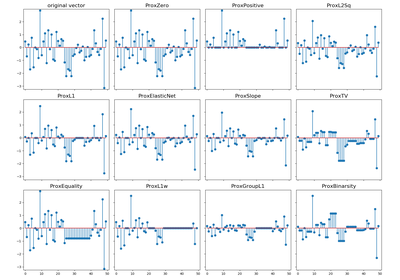tick.prox.ProxSlope¶
-
class
tick.prox.ProxSlope(strength: float, fdr: float = 0.6, range: tuple = None, positive: bool = False)[source]¶ Proximal operator of Slope penalization. This penalization is particularly relevant for feature selection, in generalized linear models, when features correlation is not too high.
- Parameters
strength :
floatLevel of penalization
fdr :
float, default=0.6Desired False Discovery Rate for detection of non-zeros in the coefficients. Must be between 0 and 1.
range :
tupleof twoint, default=`None`Range on which the prox is applied. If
Nonethen the prox is applied on the whole vector- Attributes
weights :
np.array, shape=(n_coeffs,)The weights used in the penalization. They are automatically setted, depending on the
weights_typeandfdrparameters.dtype :
{'float64', 'float32'}Type of the arrays used.
Notes
Uses the stack-based algorithm for FastProxL1 from
SLOPE–Adaptive Variable Selection via Convex Optimization, by Bogdan, M. and Berg, E. van den and Sabatti, C. and Su, W. and Candes, E. J. arXiv preprint arXiv:1407.3824, 2014
-
__init__(strength: float, fdr: float = 0.6, range: tuple = None, positive: bool = False)[source]¶ Initialize self. See help(type(self)) for accurate signature.
-
call(coeffs, step=1.0, out=None)¶ Apply proximal operator on a vector. It computes:
\[argmin_x \big( f(x) + \frac{1}{2} \|x - v\|_2^2 \big)\]- Parameters
coeffs :
numpy.ndarray, shape=(n_coeffs,)Input vector on which is applied the proximal operator
step :
floatornp.array, default=1.The amount of penalization is multiplied by this amount
If
float, the amount of penalization is multiplied by this amountIf
np.array, then each coordinate of coeffs (within the given range), receives an amount of penalization multiplied by t (available only for separable prox)
out :
numpy.ndarray, shape=(n_params,), default=NoneIf not
None, the output is stored in the givenout. Otherwise, a new vector is created.- Returns
output :
numpy.ndarray, shape=(n_coeffs,)Same object as out
Notes
stepmust have the same size ascoeffswhenever range isNone, or a size matching the one given by the range otherwise
